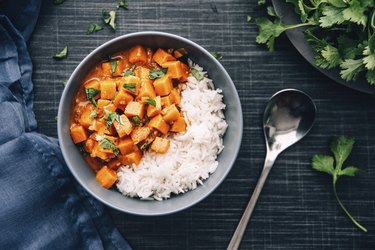
Americans eat a significant amount of rice, with many eating white rice every day. Eating too much rice could provide you with too many carbohydrates and not enough vitamin C. It can also raise your risk for Type 2 diabetes and cardiovascular disease.
Tip
If you eat too much cooked rice, you might not be getting the nutrients you need. You could be consuming too many carbohydrates and increasing your risk of Type 2 diabetes and cardiovascular disease.
Video of the Day
Rice Isn't Nutrient Rich
According to USDA FoodData Central, a single cup of cooked short-grain, enriched white rice contains 53 grams of carbohydrates, 2 grams of calcium, 2.72 grams of iron, 15 grams of magnesium, 4.39 grams of protein and 242 calories.
There are also small amounts of vitamins like folate and thiamine, as well as minerals like potassium, phosphorus and iron. There is absolutely no vitamin C, vitamin A or vitamin D among the vitamins in rice, and very little sodium, even in fortified short-grain white rice. Unenriched short-grain white rice contains even less of these vitamins and minerals.
Video of the Day
Rice has a minimal amount of important macronutrients and micronutrients. Eating too much rice and not enough of other foods with diverse nutrients could leave you with a nutrient deficiency. Your diet should mainly consist of a variety of fruits, vegetables and proteins, depending on your health status and your age.
High Carbohydrate Content
Rice may seem like it doesn't have a lot of calories, but it contains plenty of carbohydrates. While there are some vitamins in rice, there aren't a lot of important macronutrients. The Dietary Guidelines for Americans recommends getting between 45 percent and 65 percent of your daily calorie intake from carbohydrates. For someone who consumes 2,000 calories a day, that translates to between 900 calories and 1300 calories from carbohydrates.
Due to its high fiber content (4 grams per cup for white rice and 7 grams per cup for brown rice), rice can be filling, leaving you with no space in your stomach for other foods. You should also get other nutrients from your food, such as protein and fat, which are virtually nonexistent in rice.
Eating a diet loaded with fruits, vegetables and proteins is important for getting all of the nutrients you need. HelpGuide.org recommends eating five servings of fruits and vegetables every day. If you're eating too much rice, you may not be getting enough nutrients from fruits and vegetables. There just aren't enough vitamins in rice, especially in unenriched white rice.
Read more: List of Good Carbohydrates to Eat
The Glycemic Index Problem
According to a January 2017 analysis published in BMC Public Health, people who are used to eating white rice every day are at a higher risk of developing Type 2 diabetes. The danger is particularly great for white rice, as compared to brown rice.
Brown rice has a lot more nutrients than white rice, such as dietary fiber, vitamins and minerals. White rice, however, has had the bran and germ stripped off during the milling process, and has lost most of these nutrients, although some of them are added back during the enrichment process. White rice is composed almost entirely of carbohydrates.
The glycemic index, or GI, is a measure of how fast a food causes a spike in blood sugars when it is consumed. Foods with a glycemic index over 70 are considered to be high GI foods. According to Harvard Health, white rice has a GI of approximately 73, which means it can cause blood sugar levels to rise suddenly when eaten.
When this happens too frequently, such as when eating white rice every day, it may affect the metabolism of glucose and the production of insulin in a negative way, leading to a higher risk of diabetes. A January 2015 analysis published in the American Journal of Clinical Nutrition showed that eating too much rice has also been linked to a higher risk of cardiovascular disease by at least one study.
Rice is rarely eaten by itself, because it lacks flavor. It is typically used as a filler, and mixed with sauces or butter. When eaten in this way, one can gain a lot more calories, not just from eating too much rice, but also simply because of the foods the rice accompanies. Just a bit of butter or some sauce can increase the calories consumed by more than twice what you'd expect from a cup of cooked rice.
- USDA FoodData Central: "Rice, White, Short-Grain, Enriched, Cooked"
- Health.gov: "Dietary Guidelines for Americans, 2015-2020"
- HelpGuide.org: "Healthy Eating"
- BMC Public Health: "White Rice Intake and Incidence of Type-2 Diabetes Analysis of Two Prospective Cohort Studies From Iran"
- Harvard Health Publishing: "Glycemic Index for 60+ Foods"
- American Journal of Clinical Nutrition: "Rice Consumption and Risk of Cardiovascular Disease: Results From a Pooled Analysis of 3 U.S. Cohorts"